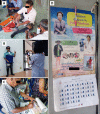Feasibility and initial outcomes of a multifaceted prevention programme of melioidosis in diabetic patients in Ubon Ratchathani, northeast Thailand
- PMID: 30188902
- PMCID: PMC6143272
- DOI: 10.1371/journal.pntd.0006765
Feasibility and initial outcomes of a multifaceted prevention programme of melioidosis in diabetic patients in Ubon Ratchathani, northeast Thailand
Abstract
Background: Melioidosis is an infection caused by Burkholderia pseudomallei, a Gram-negative bacillus found in soil and water. Diabetes mellitus is the most important risk factor for melioidosis. The recommendations for disease prevention include avoiding direct contact with soil and water, and drinking only boiled or bottled water.
Methods: A prospective intervention study was conducted to evaluate the feasibility and behavioural outcomes of a multifaceted prevention programme for melioidosis. Participants were diabetic adults in Ubon Ratchathani, northeast Thailand. Ten behavioural support groups consisting of 6 to 10 participants per group were conducted. Twelve behaviour change techniques were used: information about health consequences, credible source, adding objects to the environment, reconstructing the physical environment, instruction on how to perform a behaviour, demonstration of the behaviour, commitment, prompts/cues, self-monitoring of behaviour, goal setting, feedback on behaviour, and social support, and their feasibilities evaluated.
Results: There were 70 participants, of median age 59 years and 52 (74%) were female. Participants found the intervention beneficial, interesting and engaging. Participants indicated that they liked to watch videos with information about melioidosis delivered by local doctors and patients who survived melioidosis, and videos showing use of over-the-knee boots by local farmers. Participants felt engaged in the sessions that trialed protective gear and that made calendars with individual photographs and self-pledges as a reminder tool. The proportions of participants reporting that they always wore boots while working in rice fields increased from 30% (10/33) to 77% (28/37, p = 0.04), and that they drank only boiled or bottle water increased from 43% (30/70) to 86% (59/69, p<0.001) at 6 months post intervention.
Conclusion: The programme is highly acceptable to participants, and can support behaviour change. Policy makers should consider implementing the programme in areas where melioidosis is endemic. Making calendars with individual photographs and self-pledges as a reminder tool could be powerful in behaviour change interventions, and further research on this component is needed.
Conflict of interest statement
The authors have declared that no competing interests exist.
Figures

Similar articles
-
Effectiveness of a multifaceted prevention programme for melioidosis in diabetics (PREMEL): A stepped-wedge cluster-randomised controlled trial.PLoS Negl Trop Dis. 2021 Jun 25;15(6):e0009060. doi: 10.1371/journal.pntd.0009060. eCollection 2021 Jun. PLoS Negl Trop Dis. 2021. PMID: 34170931 Free PMC article. Clinical Trial.
-
Barriers and Recommended Interventions to Prevent Melioidosis in Northeast Thailand: A Focus Group Study Using the Behaviour Change Wheel.PLoS Negl Trop Dis. 2016 Jul 29;10(7):e0004823. doi: 10.1371/journal.pntd.0004823. eCollection 2016 Jul. PLoS Negl Trop Dis. 2016. PMID: 27472421 Free PMC article.
-
Public awareness of melioidosis in Thailand and potential use of video clips as educational tools.PLoS One. 2015 Mar 24;10(3):e0121311. doi: 10.1371/journal.pone.0121311. eCollection 2015. PLoS One. 2015. PMID: 25803048 Free PMC article.
-
Burkholderia pseudomallei: the unbeatable foe?Southeast Asian J Trop Med Public Health. 1998 Jun;29(2):410-5. Southeast Asian J Trop Med Public Health. 1998. PMID: 9886137 Review.
-
A systematic review of recruitment strategies and behaviour change techniques in group-based diabetes prevention programmes focusing on uptake and retention.Diabetes Res Clin Pract. 2020 Aug;166:108273. doi: 10.1016/j.diabres.2020.108273. Epub 2020 Jun 23. Diabetes Res Clin Pract. 2020. PMID: 32590009
Cited by
-
Effectiveness of a multifaceted prevention programme for melioidosis in diabetics (PREMEL): A stepped-wedge cluster-randomised controlled trial.PLoS Negl Trop Dis. 2021 Jun 25;15(6):e0009060. doi: 10.1371/journal.pntd.0009060. eCollection 2021 Jun. PLoS Negl Trop Dis. 2021. PMID: 34170931 Free PMC article. Clinical Trial.
-
Theory-Informed Design of a Tailored Strategy for Implementing Household TB Contact Investigation in Uganda.Front Public Health. 2022 Mar 24;10:837211. doi: 10.3389/fpubh.2022.837211. eCollection 2022. Front Public Health. 2022. PMID: 35400072 Free PMC article.
-
Drivers of melioidosis endemicity: epidemiological transition, zoonosis, and climate change.Curr Opin Infect Dis. 2022 Jun 1;35(3):196-204. doi: 10.1097/QCO.0000000000000827. Curr Opin Infect Dis. 2022. PMID: 35665713 Free PMC article. Review.
References
-
- Limmathurotsakul D, Kanoksil M, Wuthiekanun V, Kitphati R, deStavola B, Day NP, et al. Activities of daily living associated with acquisition of melioidosis in northeast Thailand: a matched case-control study. PLoS Negl Trop Dis. 2013;7(2):e2072 10.1371/journal.pntd.0002072 ; PubMed Central PMCID: PMC3578767. - DOI - PMC - PubMed
Publication types
MeSH terms
Associated data
Grants and funding
LinkOut - more resources
Full Text Sources
Other Literature Sources
Medical

